SLES230A September 2008 – August 2015 PCM2912A
PRODUCTION DATA.
- 1 Features
- 2 Applications
- 3 Description
- 4 Revision History
- 5 Device Comparison Table
- 6 Pin Configuration and Functions
-
7 Specifications
- 7.1 Absolute Maximum Ratings
- 7.2 ESD Ratings
- 7.3 Recommended Operating Conditions
- 7.4 Thermal Information
- 7.5 Electrical Characteristics
- 7.6
Typical Characteristics
- 7.6.1 ADC Digital Decimation Filter Frequency Response
- 7.6.2 ADC Digital High-Pass Filter Frequency Response
- 7.6.3 ADC Analog Antialiasing Filter Frequency Response
- 7.6.4 DAC Digital Interpolation Filter Frequency Response
- 7.6.5 DAC Analog FIR Filter Frequency Response
- 7.6.6 DAC Analog Low-Pass Filter Frequency Response
- 7.6.7 ADC
- 7.6.8 DAC
- 7.6.9 Supply Current
- 8 Parameter Measurement Information
-
9 Detailed Description
- 9.1 Overview
- 9.2 Functional Block Diagram
- 9.3 Feature Description
- 9.4 Device Functional Modes
- 9.5 Programming
- 10Application and Implementation
- 11Power Supply Recommendations
- 12Layout
- 13Device and Documentation Support
- 14Mechanical, Packaging, and Orderable Information
Package Options
Mechanical Data (Package|Pins)
- PJT|32
Thermal pad, mechanical data (Package|Pins)
Orderable Information
7 Specifications
7.1 Absolute Maximum Ratings
Over operating free-air temperature range (unless otherwise noted).(1)(2)| MIN | MAX | UNIT | ||
|---|---|---|---|---|
| Supply voltage | VBUS | –0.3 | 6.5 | V |
| Ground voltage differences | BGND, PGND, AGND, HGND, DGND | –0.1 | 0.1 | V |
| Input voltage | VCCP, VCCA, VCCL, VCCR, VDD | –0.3 | 4 | V |
| Digital input voltage | PLAY, REC | –0.3 | 6.5 | V |
| D+, D–, XTI, XTO, MMUTE, TEST0, TEST1, POWER, MAMP, SSPND | –0.3 | 4 | V | |
| Analog input voltage | MBIAS, VIN, VCOM1, VCOM2, VOUTL, VOUTR, FR, FL | –0.3 | 4 | V |
| Input current (any pins except supplies) | –10 | 10 | mA | |
| Ambient temperature under bias | –40 | 125 | °C | |
| Junction temperature | 150 | |||
| Storage temperature, Tstg | –55 | 150 | ||
(1) Stresses beyond those listed under Absolute Maximum Ratings may cause permanent damage to the device. These are stress ratings only, and functional operation of the device at these or any other conditions beyond those indicated under Recommended Operating Conditions is not implied. Exposure to absolute-maximum-rated conditions for extended periods may affect device reliability.
(2) All voltage values are with respect to network ground terminal.
7.2 ESD Ratings
| VALUE | UNIT | |||
|---|---|---|---|---|
| V(ESD) | Electrostatic discharge | Human body model (HBM), per ANSI/ESDA/JEDEC JS-001(1) | ±3000 | V |
| Charged device model (CDM), per JEDEC specification JESD22-C101(2) | ±1000 | |||
(1) JEDEC document JEP155 states that 500-V HBM allows safe manufacturing with a standard ESD control process.
(2) JEDEC document JEP157 states that 250-V CDM allows safe manufacturing with a standard ESD control process.
7.3 Recommended Operating Conditions
Over operating free-air temperature range (unless otherwise noted).| MIN | NOM | MAX | UNIT | ||
|---|---|---|---|---|---|
| VBUS | Supply voltage | 4.35 | 5 | 5.25 | V |
| Analog input voltage, full scale (–0 dB) | 0.43 VCCA | VPP | |||
| Digital input logic family | TTL | ||||
| Digital input clock frequency | 5.997 | 6 | 6.003 | MHz | |
| Analog output load resistance | 32 | Ω | |||
| Analog output load capacitance | 100 | pF | |||
| Digital output load capacitance | 10 | pF | |||
| TA | Operating free-air temperature | –25 | 70 | °C | |
7.4 Thermal Information
| THERMAL METRIC(1) | PCM2912A | UNIT | |
|---|---|---|---|
| PJT (TQFP) | |||
| 32 PINS | |||
| RθJA | Junction-to-ambient thermal resistance | 69.6 | °C/W |
| RθJC(top) | Junction-to-case (top) thermal resistance | 10.6 | °C/W |
| RθJB | Junction-to-board thermal resistance | 34.6 | °C/W |
| ψJT | Junction-to-top characterization parameter | 0.3 | °C/W |
| ψJB | Junction-to-board characterization parameter | 33.9 | °C/W |
(1) For more information about traditional and new thermal metrics, see the Semiconductor and IC Package Thermal Metrics application report, SPRA953.
7.5 Electrical Characteristics
All specifications at TA = 25°C, VBUS = 5 V, fS = 44.1 kHz, fIN = 1 kHz, and 16-bit data, unless otherwise noted. for Host interface, apply USB revision 2.0, full-speed. For audio data format, use UsB isochronous data format.| PARAMETER | TEST CONDITIONS | MIN | TYP | MAX | UNIT | |
|---|---|---|---|---|---|---|
| INPUT LOGIC | ||||||
| VIH | Input logic high level | 2 | 3.3 | VDC | ||
| VIL | Input logic low level | 0.8 | ||||
| IIH | Input logic high current(1)(2) | VIN = 3.3 V | –10 | 10 | μA | |
| Input logic high current(3) | VIN = 3.3 V | 65 | 100 | |||
| IIL | Input logic low current(1)(2) | VIN = 0 V | –10 | 10 | μA | |
| Input logic low current(3) | VIN = 0 V | –10 | 10 | |||
| OUTPUT LOGIC | ||||||
| VOH | Output logic high level(1) | IOH = –10 mA | 2.9 | VDC | ||
| Output logic high level(4) | IOH = –2 mA | 2.8 | ||||
| VOL | Output logic low level(1) | IOL = 10 mA | 0.3 | VDC | ||
| Output logic low level(4) | IOL = 2 mA | 0.5 | ||||
| Output logic low level(5) | IOL = 8 mA | 0.5 | ||||
| IOH | Output leak current(5) | VIN = 5 V | ±10 | μA | ||
| CLOCK FREQUENCY | ||||||
| Input clock frequency, XTI | 5.997 | 6.000 | 6.003 | MHz | ||
| MICROPHONE BIAS | ||||||
| Output voltage | 0.75 VCCA | VDC | ||||
| Output current | 2 | mA | ||||
| Output noise | RL = 1 kΩ | 5 | μVRMS | |||
| ANALOG-TO-DIGITAL CONVERTER (ADC) CHARACTERISTICS | ||||||
| Resolution | 16 | Bits | ||||
| Audio data channel | 1 | Channel | ||||
| Sampling frequency | 8 11.025 16 22.05 32 44.1 48 |
kHz | ||||
| ADC DYNAMIC PERFORMANCE(6) | ||||||
| THD+N | Total harmonic distortion plus noise | VIN = –1 dB of 0.43 VCCA | 0.01% | 0.02% | ||
| Dynamic range | A-weighted | 82 | 90 | dB | ||
| SNR | Signal-to-noise ratio | A-weighted | 84 | 92 | dB | |
| ADC DC ACCURACY | ||||||
| Gain error | ±2 | ±10 | % of FSR | |||
| Bipolar zero error | ±0 | % of FSR | ||||
| ANALOG INPUT | ||||||
| Input voltage | 0.43 VCCA | VPP | ||||
| Center voltage | 0.5 VCCA | V | ||||
| Antialiasing filter frequency response | –3 dB | 150 | kHz | |||
| fIN = 20 kHz | –0.08 | dB | ||||
| MICROPHONE AMPLIFIER | ||||||
| Gain | 0 | 20 | dB | |||
| Input impedance | 20 | kΩ | ||||
| INPUT PGA | ||||||
| Gain range | –12 | 30 | dB | |||
| Gain step size | 1 | dB | ||||
| ADC DIGITAL FILTER PERFORMANCE | ||||||
| Passband | 0.454 fS | Hz | ||||
| Stop band | 0.583 fS | Hz | ||||
| Passband ripple | –0.02 | 0.02 | dB | |||
| Stop-band attenuation | –65 | dB | ||||
| Delay time | 17.4/fS | s | ||||
| HPF frequency response | –3 dB | 0.078 fS/1000 | Hz | |||
| DIGITAL-TO-ANALOG CONVERTER (DAC) CHARACTERISTICS | ||||||
| Resolution | 16 | Bits | ||||
| Audio data channel | 1, 2 | Channel | ||||
| Sampling frequency | 8 11.025 16 22.05 32 44.1 48 |
kHz | ||||
| DAC DYNAMIC PERFORMANCE(7) | ||||||
| THD+N | Total harmonic distortion plus noise | RL > 10 kΩ, VOUT = 0 dB of 0.6 VCCA | 0.01% | 0.02% | ||
| RL = 32 Ω, VOUT = 0 dB of 0.55 VCCA | 0.02% | 0.05% | ||||
| Dynamic range | EIAJ, A-weighted | 82 | 90 | dB | ||
| SNR | Signal-to-noise ratio | EIAJ, A-weighted | 84 | 92 | dB | |
| Channel separation | RL > 10 kΩ | 80 | 88 | dB | ||
| DAC DC ACCURACY | ||||||
| Gain mismatch channel-to-channel | –10 | ±2 | 10 | % of FSR | ||
| Gain error | –10 | ±2 | 10 | % of FSR | ||
| Bipolar zero error | ±3 | % of FSR | ||||
| ANALOG OUTPUT | ||||||
| Output voltage | RL > 10 kΩ | 0.6 VCCA | VPP | |||
| RL = 32 Ω | 0.55 VCCA | |||||
| Center voltage | 0.5 VCCA | V | ||||
| Output power | RL = 32 Ω | 13 | mW | |||
| RL = 16 Ω | 25 | |||||
| Load impedance (AC coupling) | Line | 10 | kΩ | |||
| Headphone | 16 | 32 | Ω | |||
| LPF frequency response | –3 dB | 140 | kHz | |||
| f = 20 kHz | –0.1 | dB | ||||
| SIDETONE PROGRAMMABLE ATTENUATOR | ||||||
| Gain range | –76 | 0 | dB | |||
| Gain step size | 1 | dB | ||||
| OUTPUT PROGRAMMABLE ATTENUATOR | ||||||
| Gain range | –76 | 0 | dB | |||
| Gain step size | 1 | dB | ||||
| ANALOG LOOPBACK PERFORMANCE(8) | ||||||
| THD+N | Total harmonic distortion plus noise | RL > 10 kΩ, VIN = 0 dB of 0.43 VCCA | 0.01% | 0.02% | ||
| RL = 32 Ω, VIN = 0 dB of 0.43 VCCA | 0.02% | 0.05% | ||||
| Dynamic range | EIAJ, A-weighted | 82 | 90 | dB | ||
| SNR | Signal-to-noise ratio | EIAJ, A-weighted | 84 | 92 | dB | |
| DAC DIGITAL FILTER PERFORMANCE | ||||||
| Passband | 0.445 fS | Hz | ||||
| Stop band | 0.555 fS | Hz | ||||
| Passband ripple | ±0.1 | dB | ||||
| Stop-band attenuation | –43 | dB | ||||
| Delay time | 14.3/fS | s | ||||
| POWER-SUPPLY REQUIREMENTS | ||||||
| VBUS | Voltage range | Bus-powered | 4.35 | 5 | 5.25 | VDC |
| Supply current | ADC, DAC operation (RL = 32 Ω) | 85 | 100 | mA | ||
| Suspend mode(9) | 220 | 300 | μA | |||
| Power dissipation | ADC, DAC Operation | 425 | 500 | mW | ||
| Suspend mode(9) | 0.8 | 1 | mW | |||
| VCCP,VCCL VCCR,VCCA VDD | Internally-generated power supply voltage(10) | 3 | 3.3 | 3.6 | VDC | |
| TEMPERATURE RANGE | ||||||
| Operation temperature | –25 | 85 | °C | |||
(1) Pins 3, 4: D–, D+.
(2) Pins 8, 23, 24, 27, 28: XTI, MAMP, POWER, TEST1, TEST0
(3) Pin 30: MMUTE
(4) Pins 7, 29: XTO, SSPND
(5) Pins 31, 32: REC, PLAY.
(6) fIN = 1 kHz, using Audio Precision™System Two™, RMS mode with 20-kHz LPF, 400-Hz HPF in calculation. Microphone amplifier = 0 dB, PGA = 0 dB.
(7) fOUT = 1 kHz, using Audio Precision System Two, RMS mode with 20-kHz LPF, 400-Hz HPF. Output attenuator = 0 dB,
Sidetone = Mute.
Sidetone = Mute.
(8) MIC Amp = 0 dB, Sidetone attenuator = 0 dB, Output attenuator = 0 dB.
(9) Under USB suspend state
(10) Pins 5, 15, 19, 21, 26: VDD, VCCA, VCCL, VCCR, VCCP.
7.6 Typical Characteristics
7.6.1 ADC Digital Decimation Filter Frequency Response
All specifications at TA = 25°C, VBUS = 5 V, fS = 44.1 kHz, fIN = 1 kHz, and 16-bit data, unless otherwise noted.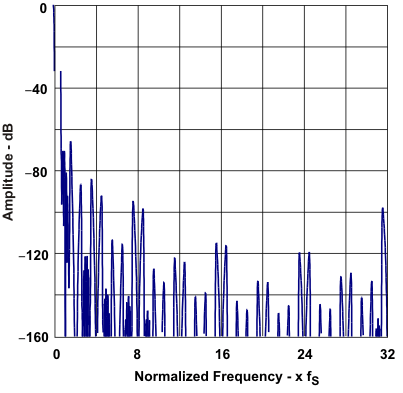 Figure 1. Overall Characteristic
Figure 1. Overall Characteristic
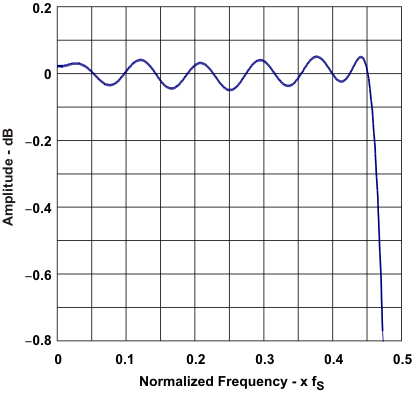 Figure 3. Passband Ripple
Figure 3. Passband Ripple
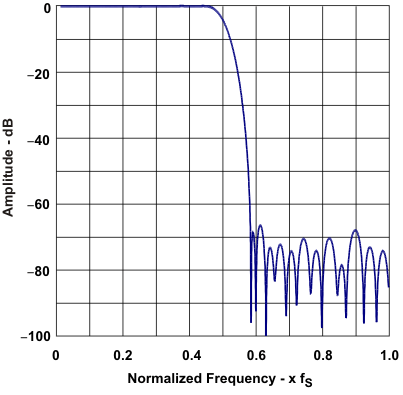 Figure 2. Stop Band Attenuation
Figure 2. Stop Band Attenuation
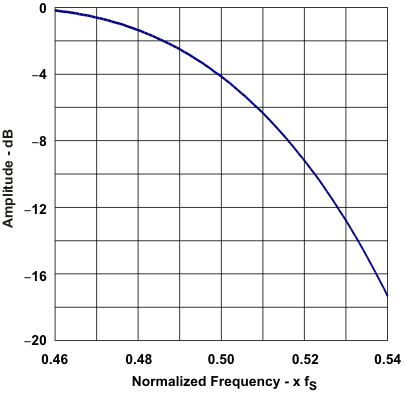 Figure 4. Transient Band Response
Figure 4. Transient Band Response
7.6.2 ADC Digital High-Pass Filter Frequency Response
All specifications at TA = 25°C, VBUS = 5 V, fS = 44.1 kHz, fIN = 1 kHz, and 16-bit data, unless otherwise noted.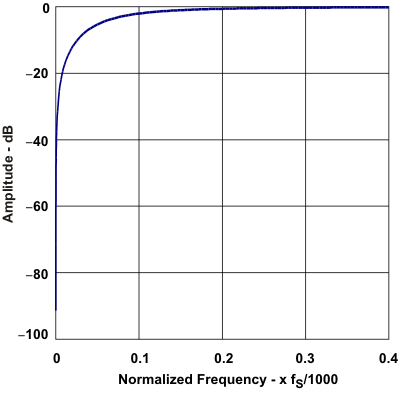 Figure 5. Stop Band Characteristic
Figure 5. Stop Band Characteristic
 Figure 6. Passband Characteristic
Figure 6. Passband Characteristic
7.6.3 ADC Analog Antialiasing Filter Frequency Response
All specifications at TA = 25°C, VBUS = 5 V, fS = 44.1 kHz, fIN = 1 kHz, and 16-bit data, unless otherwise noted.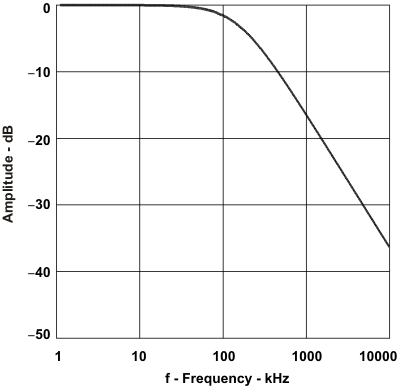 Figure 7. Stop Band Characteristic
Figure 7. Stop Band Characteristic
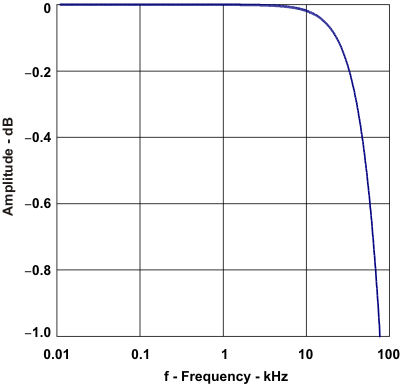 Figure 8. Passband Characteristic
Figure 8. Passband Characteristic
7.6.4 DAC Digital Interpolation Filter Frequency Response
All specifications at TA = 25°C, VBUS = 5 V, fS = 44.1 kHz, fIN = 1 kHz, and 16-bit data, unless otherwise noted.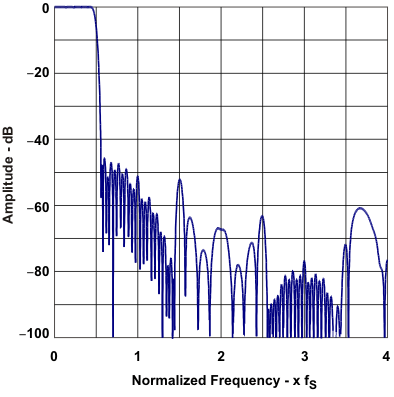 Figure 9. Stop Band Attenuation
Figure 9. Stop Band Attenuation
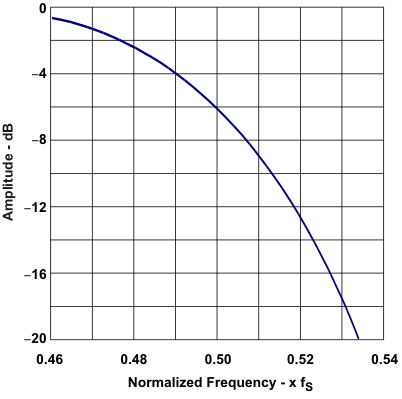 Figure 11. Transient Band Response
Figure 11. Transient Band Response
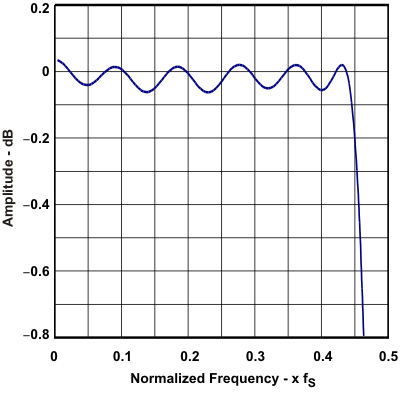 Figure 10. Passband Ripple
Figure 10. Passband Ripple
7.6.5 DAC Analog FIR Filter Frequency Response
All specifications at TA = 25°C, VBUS = 5 V, fS = 44.1 kHz, fIN = 1 kHz, and 16-bit data, unless otherwise noted.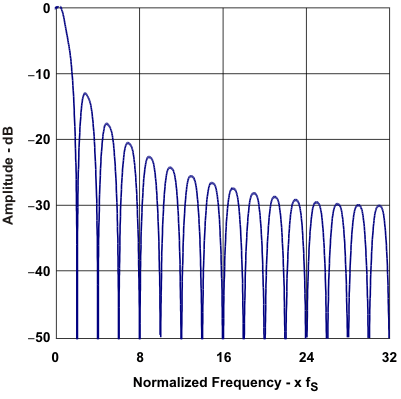 Figure 12. Stop Band Characteristic
Figure 12. Stop Band Characteristic
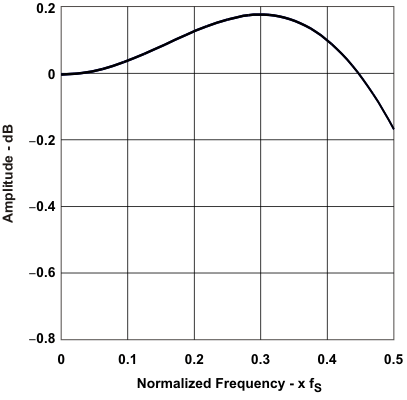 Figure 13. Passband Characteristic
Figure 13. Passband Characteristic
7.6.6 DAC Analog Low-Pass Filter Frequency Response
All specifications at TA = 25°C, VBUS = 5 V, fS = 44.1 kHz, fIN = 1 kHz, and 16-bit data, unless otherwise noted.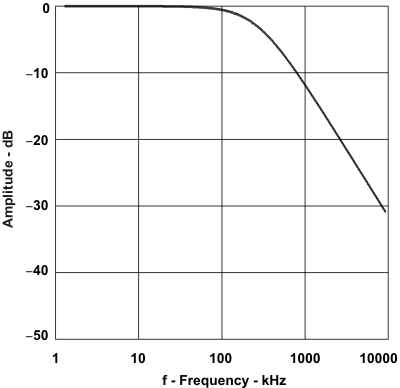 Figure 14. Stop Band Characteristic
Figure 14. Stop Band Characteristic
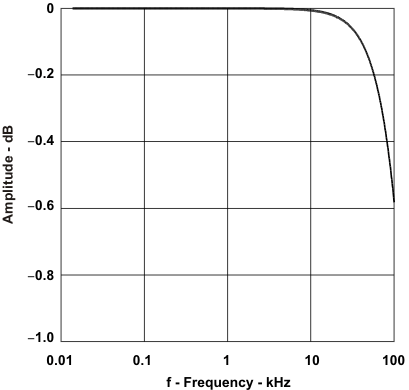 Figure 15. Passband Characteristic
Figure 15. Passband Characteristic
7.6.7 ADC
All specifications at TA = 25°C, VBUS = 5 V, fS = 44.1 kHz, fIN = 1 kHz, and 16-bit data, unless otherwise noted.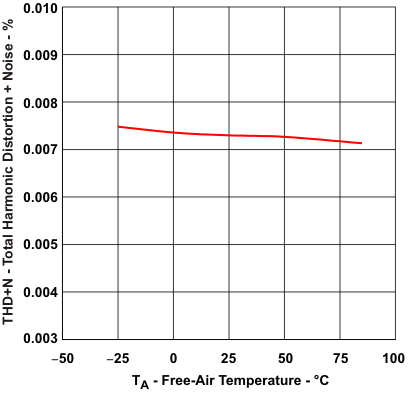 Figure 16. THD+N at –1 dB vs Temperature
Figure 16. THD+N at –1 dB vs Temperature
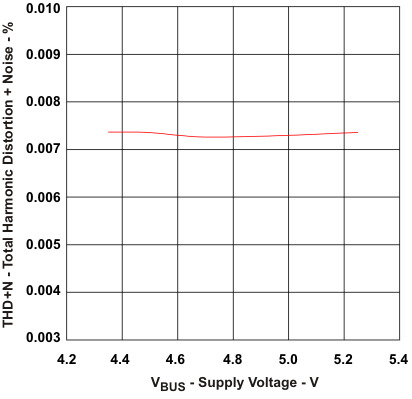 Figure 18. THD+N at –1 dB vs Supply Voltage
Figure 18. THD+N at –1 dB vs Supply Voltage
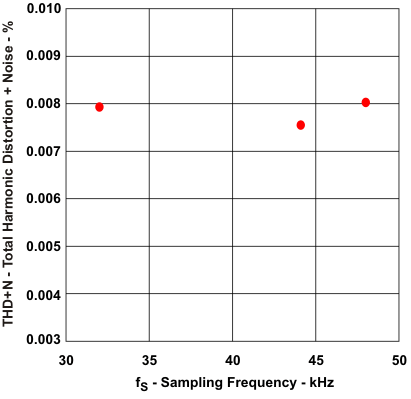 Figure 20. THD+N at –1 dB vs Sampling Frequency
Figure 20. THD+N at –1 dB vs Sampling Frequency
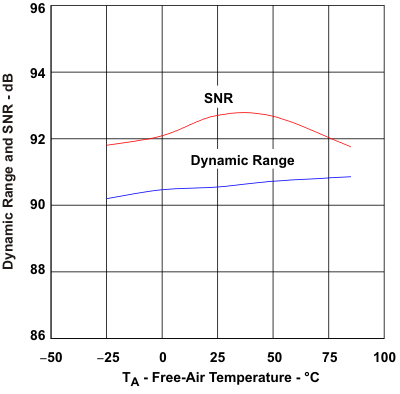 Figure 17. Dynamic Range and Signal-to-Noise Ratio vs Temperature
Figure 17. Dynamic Range and Signal-to-Noise Ratio vs Temperature
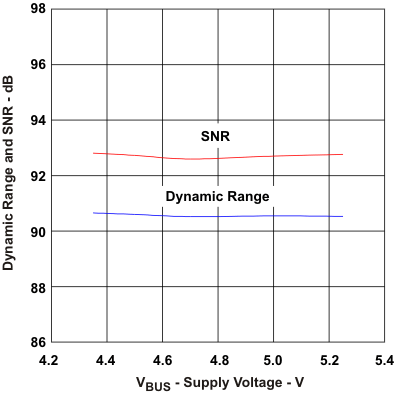 Figure 19. Dynamic Range and Signal-to-Noise Ratio vs Supply Voltage
Figure 19. Dynamic Range and Signal-to-Noise Ratio vs Supply Voltage
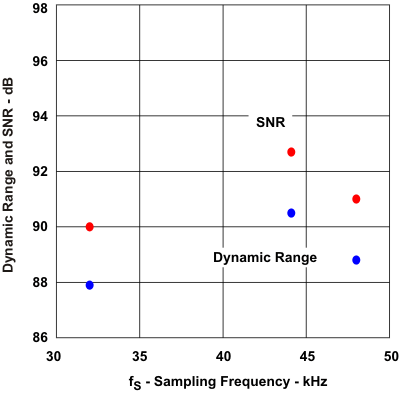 Figure 21. Dynamic Range and Signal-to-Noise Ratio vs Sampling Frequency
Figure 21. Dynamic Range and Signal-to-Noise Ratio vs Sampling Frequency
7.6.8 DAC
All specifications at TA = 25°C, VBUS = 5 V, fS = 44.1 kHz, fIN = 1 kHz, and 16-bit data, unless otherwise noted.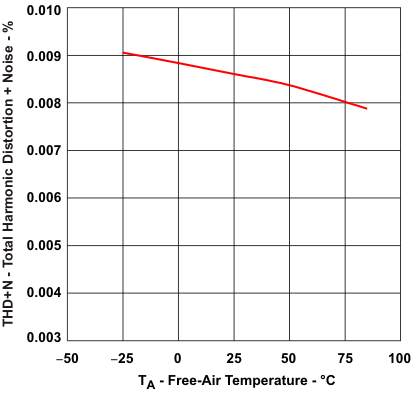 Figure 22. THD+N at 0 dB vs Temperature
Figure 22. THD+N at 0 dB vs Temperature
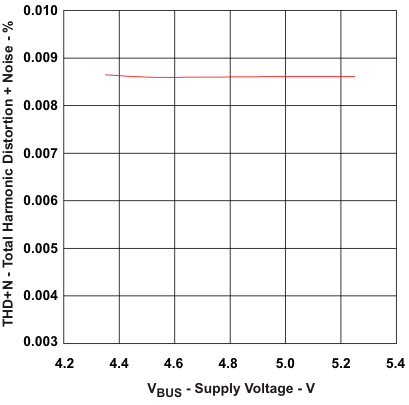 Figure 24. THD+N at 0 dB vs Supply Voltage
Figure 24. THD+N at 0 dB vs Supply Voltage
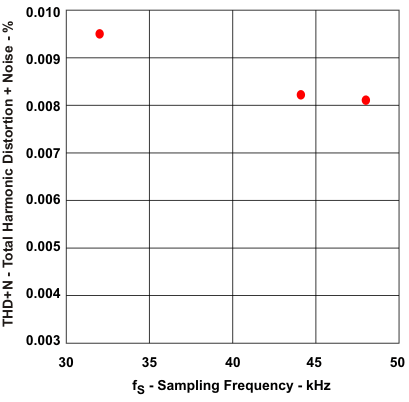 Figure 26. THD+N at 0 dB vs Sampling Frequency
Figure 26. THD+N at 0 dB vs Sampling Frequency
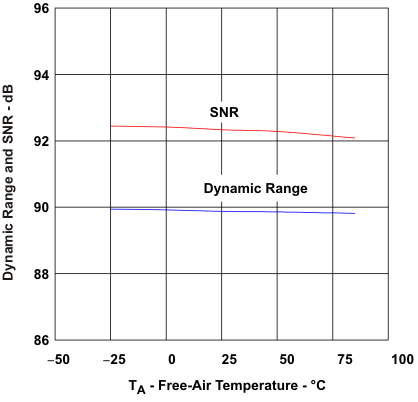 Figure 23. Dynamic Range and Signal-to-Noise Ratio vs Temperature
Figure 23. Dynamic Range and Signal-to-Noise Ratio vs Temperature
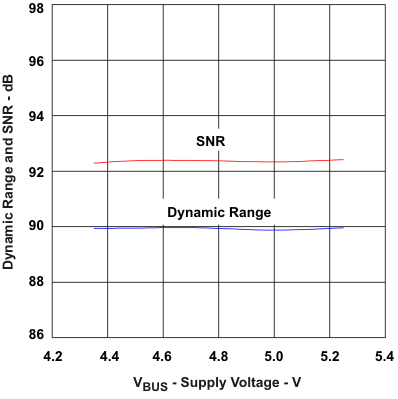 Figure 25. Dynamic Range and Signal-to-Noise Ratio vs Supply Voltage
Figure 25. Dynamic Range and Signal-to-Noise Ratio vs Supply Voltage
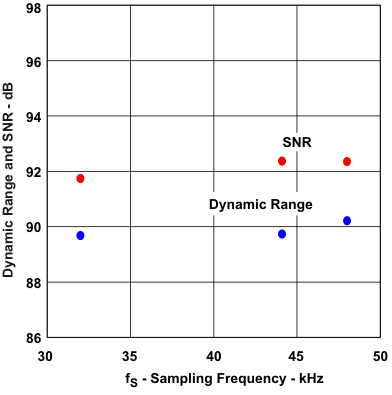 Figure 27. Dynamic Range and Signal-to-Noise Ratio vs Sampling Frequency
Figure 27. Dynamic Range and Signal-to-Noise Ratio vs Sampling Frequency
7.6.9 Supply Current
All specifications at TA = 25°C, VBUS = 5 V, fS = 44.1 kHz, fIN = 1 kHz, and 16-bit data, unless otherwise noted.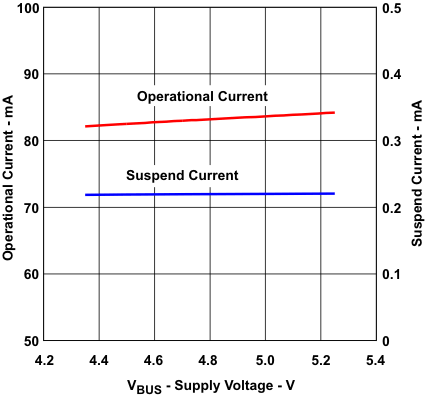 Figure 28. Supply Current vs Supply Voltage
Figure 28. Supply Current vs Supply Voltage
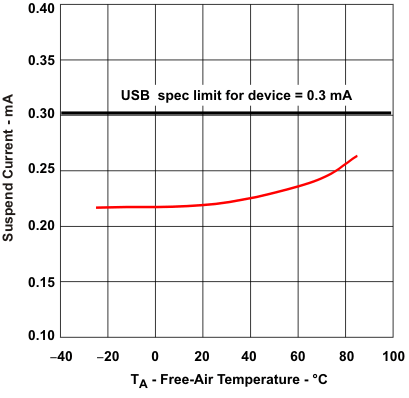 Figure 30. Supply Current vs Temperature at Suspend Mode
Figure 30. Supply Current vs Temperature at Suspend Mode
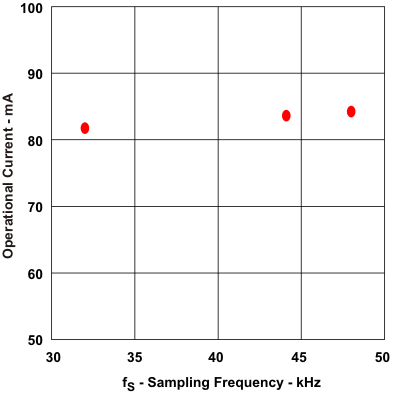 Figure 29. Supply Current vs Sampling Frequency
Figure 29. Supply Current vs Sampling Frequency